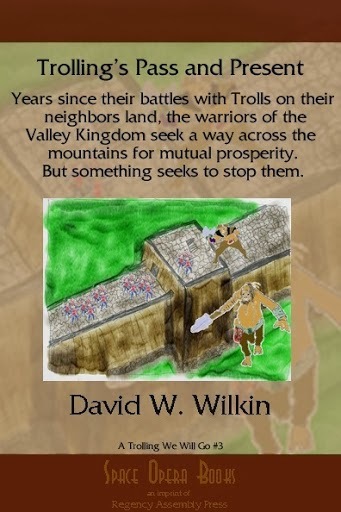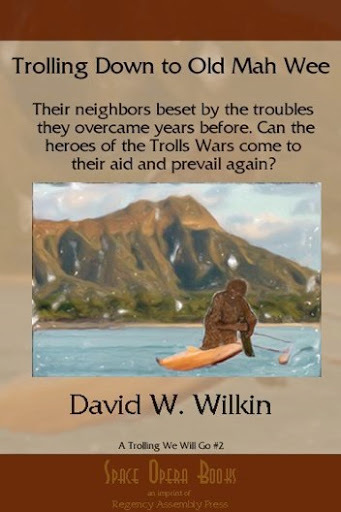D.W. Wilkin's Blog, page 32
August 24, 2016
Space Opera Books Presents Trolling, Trolling, Trolling Fly Hides
Trolling, Trolling, Trolling Fly Hides!
Not only do I write Regency and Romance, but I also have delved into Fantasy.
The Trolling series, (the first three are in print) is the story of a man, Humphrey. We meet him as he has left youth and become a man with a man’s responsibilities.
We follow him in a series of stories that encompass the stages of life. We see him when he starts his family, when he has older sons and the father son dynamic is tested.
We see him when his children begin to marry and have children, and at the end of his life when those he has loved, and those who were his friends proceed him over the threshold into death. All this while he serves a kingdom troubled by monsters.
Troubles that he and his friends will learn to deal with and rectify.
It is now available in a variety of formats. For $2.99 you can get this fantasy adventure.
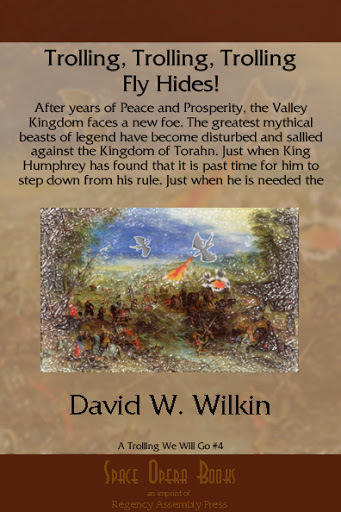
Barnes and Noble for your Nook
Old age is catching up to Humphrey and his friends. He feels it in his bones and with his son and heir having reached the prime of his life, it could very well be time to pass the baton of rule to Daniel.With the Valley Kingdom of Torahn at Peace, that would not be a terrible thing to do. Though breaking his decision to his wife Gwendolyn, the Queen, might be the hardest battle that he ever would fight.
Even as the life of retirement looks to be attractive and possible, however, the Valley Kingdom is beset again. Not Goblins, Trolls, Giants or Men, this time. No. That Humphrey knew would be far too easy.
Those obstacles had been overcome before and the problems they presented had solutions that the army of Torahn was trained to deal with. No, of all the creatures that came forth from Teantellen that they had beaten, the one they had never faced now came forth. Dragons!
Who in the realm knew how to fight these mythical beasts? Was there even away to do so?
Now Humphrey who had thought to spend the remainder of his days quietly writing his memoirs and drinking, was faced with the greatest challenge he had ever known.
Feedback
If you have any commentary, thoughts, ideas about the book (especially if you buy it, read it and like it
August 23, 2016
Regency Personalities Series-Arthur Aikin
Regency Personalities Series
In my attempts to provide us with the details of the Regency, today I continue with one of the many period notables.
Arthur Aikin
19 May 1773 – 15 April 1854
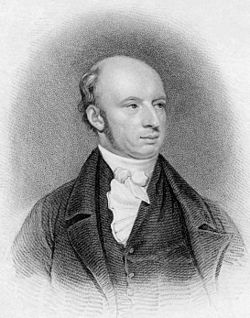
Arthur Aikin
Arthur Aikin was born at Warrington, Lancashire into a distinguished literary family of prominent Unitarians. The best known of these was his paternal aunt, Anna Letitia Barbauld, a woman of letters who wrote poetry and essays as well as early children’s literature. His father, Dr John Aikin, was a medical doctor, historian, and author. His grandfather, also called John (1713–1780), was a Unitarian scholar and theological tutor, closely associated with Warrington Academy. His sister Lucy (1781–1864) was a historical writer. Their brother Charles was adopted by their famous aunt and brought up as their cousin.
Arthur Aikin studied chemistry under Joseph Priestley in the New College at Hackney, and gave attention to the practical applications of the science. In early life he was a Unitarian minister for a short time. Aikin lectured on chemistry at Guy’s Hospital for thirty-two years. He became the President of the British Mineralogical Society in 1801 for five years up until 1806 when the Society merged with the Askesian Society. From 1803 to 1808 he was editor of the Annual Review. In 1805 Aiken also became a Proprietor of the London Institution, which was officially founded in 1806. He was one of the founders of the Geological Society of London in 1807 and was its honorary secretary in 1812–1817. He also gave lectures in 1813 and 1814. He contributed papers on the Wrekin and the Shropshire coalfield, among others, to the transactions of that society. His Manual of Mineralogy was published in 1814. Later he became the paid Secretary of the Society of Arts and later was elected as a Fellow. He was founder of the Chemical Society of London in 1841, being its first Treasurer and, between 1843 and 1845, second President.
In order to support himself, outside of his work with the British Mineralogical Society, the London Institution and the Geological Society, Aiken worked as a writer, translator and lecturer to the public and to medical students at Guy’s Hospital. His writing and journalism were useful for publicising foreign scientific news to the wider British public. He was also a member of the Linnean Society and in 1820 joined the Institution of Civil Engineers.
He was highly esteemed as a man of sound judgement and wide knowledge. Aikin never married, and died at Hoxton in London in 1854.
Journal of a Tour through North Wales and Part of Shropshire with Observations in Mineralogy and Other Branches of Natural History (London, 1797)
A Manual of Mineralogy (1814; ed. 2, 1815)
A Dictionary of Chemistry and Mineralogy (with his brother C. R. Aikin), 2 vols. (London, 1807, 1814).
For Rees’s Cyclopædia he wrote articles about Chemistry, Geology and Mineralogy, but the topics are not known.


An Unofficial Guide to how to win the Scenarios of Wild the 2nd Expansion for Rollercoaster Tycoon 3
An Unofficial Guide to how to win the Scenarios of Wild
I have been a fan of this series of computer games since early in its release of the very first game. That game was done by one programmer, Chris Sawyer, and it was the first I recall of an internet hit. Websites were put up in dedication to this game where people showed off their creations, based on real amusement parks. These sites were funded by individuals, an expense that was not necessarily as cheap then as it is now. Nor as easy to program then as it might be to build a web page now.
Prima Books released game guides for each iteration of the game, Rollercoaster Tycoon 1, Rollercoaster Tycoon 2 and Rollercoaster Tycoon 3 (RCT3) but not for the expansion sets. And unlike the first two works, the third guide was riddle with incorrect solutions. As I played the game that frustrated me. And I took to the forums that Atari, the game publisher hosted to see if I could find a way to solve those scenarios that the Prima Guide had written up in error. Not finding any good advice, I created my own for the scenarios that the “Official” Guide had gotten wrong.
Solutions that if you followed my advice you would win the scenario and move on. But if you followed the “Official” version you would fail and not be able to complete the game. My style and format being different than the folks at Prima, I continued for all the Scenarios that they had gotten right as well, though my solutions cut to the chase and got you to the winner’s circle more quickly, more directly.
My contributions to the “Official” Forum, got me a place as a playtester for both expansions to the game, Soaked and Wild. And for each of these games, I wrote the guides during the play testing phase so all the play testers could solve the scenarios, and then once again after the official release to make changes in the formula in case our aiding to perfect the game had changed matters. For this, Atari and Frontier (the actual programmers of the game) placed me within the game itself.
And for the longest time, these have been free at the “Official” Forums, as well as my own website dedicated to the game. But a short time ago, I noticed that Atari, after one of its bankruptcies had deleted their forums. So now I am releasing the Guide for one and all. I have added new material and it is near 100 pages, just for the first of the three games. It is available for the Kindle at present for $2.99.
(Click on the picture to purchase)
Not only are all 12 Scenarios covered, but there are sections covering every Cheat Code, Custom Scenery, the famous Small Park Competition, the Advanced Fireworks Editor, the Flying Camera Route Editor which are all the techniques every amusement park designer needs to make a fantastic park in Rollercoaster Tycoon 3.
Scenarios for WILD!
1) Scrub Gardens
2) Ostrich Farms Plains
3) Egyptian Sand Dance
4) A Rollercoaster Odyssey
5) Zoo Rescue
6) Mine Mountain
7) Insect World
8) Rocky Coasters
9) Lost Land of the Dinosaurs
10) Tiger Forest
11) Raiders of the Lost Coaster
12) Saxon Farms


August 22, 2016
Regency Personalities Series-Philippe-Joseph Aubert de Gaspé
Regency Personalities Series
In my attempts to provide us with the details of the Regency, today I continue with one of the many period notables.
Philippe-Joseph Aubert de Gaspé
30 October 1786 – 29 January 1871
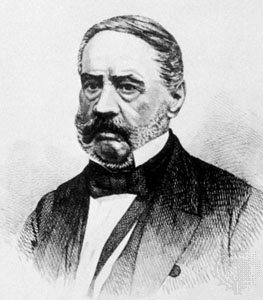
Philippe-Joseph Aubert de Gaspé
Philippe-Joseph Aubert de Gaspé was born in Quebec City in 1786, the son of seigneur Pierre-Ignace Aubert de Gaspé and Catherine Tarieu de Lanaudière, the daughter of seigneur Charles-François Tarieu de La Naudière. The Aubert de Gaspé family was distinguished, ennobled by Louis XIV in 1693. Philippe-Joseph’s grandfather, Ignace-Philippe Aubert de Gaspé, fought under Louis-Joseph de Montcalm at Carillon (Ticonderoga). Philippe-Joseph studied at the Séminaire de Québec. He studied law with Jonathan Sewell and then with Jean-Baptiste-Olivier Perrault and was called to the bar in 1811. Aubert de Gaspé served in the local militia, becoming captain. After practising law until 1816, he was appointed sheriff for Quebec district.
He became involved in debt, for which he was imprisoned four years, and when released he retired to his ancestral home at Saint-Jean-Port-Joli, Quebec, on the St. Lawrence. Aubert de Gaspé spent thirty years in study there. At the ripe age of seventy-five, he completed a novel entitled, Les Anciens Canadiens (Old-Time Canadians, Quebec, 1863). Almost entirely based on fact, the story illustrates Canadian national tradition, character and manners. The author interwove events of his own chequered life with the tragic tale of the struggles and fall of New France and of the change of regime, the eyewitnesses of which he had known personally. At that time, it was perhaps the most popular book ever published in the province of Quebec.
In 1866, Aubert de Gaspé published his Mémoires, which continue and amplify the precious historical notes contained in his other works. Less brilliant and attractive than his novel, the Mémoires are an excellent specimen of anecdotal history. The author’s standing and experience, the latter embracing directly or indirectly the space of a century dating from the Conquest, constitute him an authentic chronicler of an obscure yet eventful period of history.
Aubert de Gaspé was the last seigneur of Saint-Jean-Port-Joli. He died at Quebec City in 1871.
Several of his daughters married political figures:
Zoé married Charles Joseph Alleyn, who was also mayor of Quebec City
Suzanne married William Power, a member of the legislative assembly
Adélaïde married Georges-René Saveuse de Beaujeu
Charlotte-Elmire married Andrew Stuart, a judge and seigneur.


Fantasy from Space Opera Books, Trolling’s Pass and Present
Trolling’s Pass and Present
Not only do I write Regency and Romance, but I also have delved into Fantasy. The Trolling series, (the first three are in print) is the story of a man, Humphrey.
We meet him as he has left youth and become a man with a man’s responsibilities. We follow him in a series of stories that encompass the stages of life.
We see him when he starts his family, when he has older sons and the father son dynamic is tested. We see him when his children begin to marry and have children, and at the end of his life when those he has loved, and those who were his friends proceed him over the threshold into death.
All this while he serves a kingdom troubled by monsters. Troubles that he and his friends will learn to deal with and rectify.
It is now available in a variety of formats. For $2.99 you can get this fantasy adventure.
Barnes and Noble for your Nook
Years since their battles with the Trolls, even on foreign soil, the warriors of the Valley Kingdom of Torahn need something to keep their edge honed.
The economy too is beginning to fray a little without the great wars to support. The Leaders hit upon the idea of searching for a path to reach the east side of the continent.
The Elves swear that at one time their writings tell of such, the Dwarves swear such a pass across Teantellen is legendary. Teantellen though is filled with races man has never gotten along with well. Goblins, Dark Elves, Trolls, Giants and Dragons.
It has been years since the mountain tops exploded, and perhaps that has changed things enough that a way can be found to link the western lands with the eastern lands and increase trade, and prosperity for all. Even should they fail in their quest, as the history of man has shown to this point in time, the attempt will do much to spur the economy.
Tens of thousands of gold will be spent by the Council of Twenty-One to pay for such an expedition. Gold that those who are not so scrupulous might choose to pocket as they tried in the Troll Wars.
With such shenanigans taking place again, are the hopes of the previous generation, the leaders from the Troll Wars now in retirement, ready to be achieved? Is it time for Torahn, called the Valley Kingdom, but the only Kingdom without a King, to have a King once more?
Feedback
If you have any commentary, thoughts, ideas about the book (especially if you buy it, read it and like it
August 21, 2016
Regency Personalities Series-Armar Lowry-Corry 1st Earl Belmore
Regency Personalities Series
In my attempts to provide us with the details of the Regency, today I continue with one of the many period notables.
Armar Lowry-Corry 1st Earl Belmore
5 February 1770 – 22 December 1815
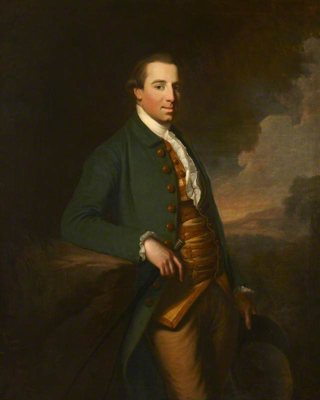
Armar Lowry-Corry
Armar Lowry-Corry 1st Earl Belmore was born Armar Lowry, the first son of Galbraith Lowry (later Lowry-Corry) MP, of Ahenis, County Tyrone by his wife Sarah Corry, second daughter and eventual co-heiress of Colonel John Corry, MP, of Castle Coole, County Fermanagh.
In 1768, Lowry was elected to the Irish House of Commons for Tyrone and sat for the constituency until 1781, when he was elevated to the Peerage of Ireland as Baron Belmore, of Castle Coole in the County of Fermanagh. On 6 December 1789 he was further created Viscount Belmore and on 20 November 1797 was created Earl Belmore, in the County of Fermanagh. Lord Belmore was High Sheriff of County Tyrone in 1769 and of County Fermanagh in 1779.
Lowry inherited the Corry family estate of Castle Coole in 1774, and took the additional name of Corry in recognition of this inheritance. The papers of the Lowry-Corry family show that the earl’s political ambitions were a significant factor in the rebuilding of Castle Coole, which is widely regarded as the most palatial Classical 18th century house in Ireland, celebrated as the masterpiece of James Wyatt. In a characteristically incisive introduction to the catalogue of the Belmore papers at the Public Record Office of Northern Ireland, Dr Anthony Malcomson writes:
“Castle Coole was built as part and parcel of Belmore’s plans for his own and his family’s political and social aggrandisement…it was well-situated to mark the nucleus of a north-western political power bloc in the Irish Parliament…That parliament, its autonomy enhanced by the so-called Constitution of 1782 looked as if it would last forever…Castle Coole therefore reflects Belmore’s confidence in his own political future and in the future of the political institutions of the day. It was to be the home of a great Irish political family: not merely a place to live in, but a showpiece to proclaim Belmore’s position in Irish society and influence in the Irish House of Commons.”
Unfortunately for Lord Belmore that confidence proved to be misplaced. Although he had inherited various family estates totaling some 70,000 acres (280 km²) and with a rent roll of at least £12,000 a year, and had risen through the ranks of the peerage, ultimately the Act of Union 1800 ended his chances of political influence. All that remained of his ambitions was Castle Coole itself, and that was really more a source of satisfaction to posterity than to himself, for he effectively handed over his various properties to his son and heir, Somerset, on his coming-of-age in 1795.
Malcomson writes that by the time of Lord Belmore’s death, the total debt affecting his estates stood at £133,000, of which about £70,000 was attributable to the building of Castle Coole, and that while the house was completed within his lifetime, it was not to be fully furnished until his son had inherited the estate.
Lord Belmore was married firstly on 3 October 1771 to Lady Margaret Butler (23 January 1748 – Apr 1775), eldest daughter of Somerset Butler, 1st Earl of Carrick by his wife Lady Juliana Boyle, first daughter by his second wife of Henry Boyle, 1st Earl of Shannon, and had issue:
Galbraith Lowry-Corry (1772–1773)
Somerset Lowry-Corry, 2nd Earl Belmore
He was married secondly on 2 March 1780 to Lady Harriet Hobart (7 April 1762 –14 July 1805), eldest daughter and co-heir of John Hobart, 2nd Earl of Buckinghamshire, who was at the time the Lord Lieutenant of Ireland, by his first wife Mary Anne Drury, first daughter and co-heiress of Lieutenant General Sir Thomas Drury, 1st Baronet, of Overstone, and had issue:
Lady Louisa Mary Anne Julia Harriet Lowry-Corry (3 April 1781 –19 April 1862), who was married to George John Montagu, 6th Earl of Sandwich, and had issue: (i) Lady Harriet Mary Montagu (14 May 1805 – 4 May 1857) and (ii) John William Montagu, 7th Earl of Sandwich (8 November 1811 – 3 March 1884)
Lord Belmore’s second marriage was subsequently dissolved by an Act of Parliament in 1793, with Lady Belmore later marrying William Kerr, 6th Marquess of Lothian. He was married for a third time on 1 March 1794 to Mary Anne Caldwell (17 April 1755 –13 December 1841), eldest daughter of Sir John Caldwell, 4th Baronet, of Castle Caldwell, County Fermanagh, by his wife Elizabeth Hort, daughter of the Most Reverend Josiah Hort, Archbishop of Tuam.
Lord Belmore died at Bath on 2 February 1802 aged 61 and was succeeded by his only surviving son.


RAP has The Shattered Mirror, A Regency Romance
The Shattered Mirror
For your enjoyment, one of the Regency Romances I published. It is available for sale and now at a reduced price of $3.99, and I hope that you will take the opportunity to order your copy.
Order for yourself or as a gift. It is now available in a variety of formats. For just a few dollars this Regency Romance can be yours for your eReaders or physically in Trade Paperback.
Barnes and Noble for your Nook
and in Trade Paperback
Bridget Halifax-Stokes was giddy with the excitement of her Season in London. Town had beckoned and her Season came on the heels of the end of the war against the tyrant. All the handsome men were returning heroes. What better year to come out?
Her father thought it all nonsense. Her mother believed that it would be the best showing of any of her daughters. More lords now available and the family’s luck that Bridget was just the perfect age.
All is fun and frivolity for Bridget until she literally crashes into Sir Patrick Hampton as he limps along the High Street. A man she knew once well from her childhood, now a stranger with dark and foreboding eyes. Eyes that had seen more than any man’s share of the war.
Feedback
If you have any commentary, thoughts, ideas about the book (especially if you buy it, read it and like it
RAP (Regency Assembly Press) in need of Beta-Readers
Regency Assembly
Press
is looking for
Beta Readers
One novel is ready for Beta Reading
We have a continuation of Pride and Prejudice with Ms Caroline Bingley and her fortune at stake:
Do we think that Mr Hurst married his Bingley Bride without incentive? It is highly probable that Caroline Bingley, even though she has a sharp, acerbic tongue, still is in possession of a fortune and an astute fortune hunter who deciphers this may soon be on the road to, if not a happy marriage, one with financial security.
Please respond or send an email if you are interested


August 20, 2016
Regency Personalities Series-General Sir John Murray 8th Baronet
Regency Personalities Series
In my attempts to provide us with the details of the Regency, today I continue with one of the many period notables.
General Sir John Murray 8th Baronet
1768 – 15 October 1827
General Sir John Murray 8th Baronet served as Quartermaster General in India from 1801 to 1805. There, “his alternations of torpor and feverish activity had greatly embarrassed the young Arthur Wellesley with whom he was supposed to be cooperating.” He married Anne Elizabeth Cholmley Phipps on 25 August 1807.
During the Second Battle of Porto in 1809, Major General Murray commanded the 7th Brigade, the largest brigade in Wellington’s army. This 2,900-strong unit included the 1st, 2nd, 5th and 7th King’s German Legion (KGL) Infantry battalions, plus elements of the 1st and 2nd KGL Light Infantry. After giving Murray two additional cavalry squadrons, Wellington entrusted him with the task of crossing the Douro River and cutting off the escape route of Marshal Nicolas Soult’s French corps. Accordingly, Murray crossed the Douro at a ferry 5 miles (8.0 km) east of Porto and moved north. However, he failed to seriously contest the French retreat to the northeast. Instead, he skirmished ineffectually with the enemy. Michael Glover, historian of the Peninsular War, calls Murray “a stupid and irresolute officer.”
He soon left Portugal because he feared he would have to serve under William Carr Beresford, who was Marshal of the Portuguese Army. Beresford was junior to Murray in British rank, but as a Marshal who would outrank him in the field. He became 8th Baronet Murray of Dunerne in 1811.
On 31 July 1812, an 8,000-man Anglo-Sicilian force under Thomas Maitland landed at Alicante on the Mediterranean coast of Spain. It then went through a succession of commanders until February 1813, when Murray, now a Lieutenant-General, took command. By this time, the force was 10,000 men strong. Of these, 3,000 were Sicilians and Italians, while the rest were British and KGL troops. Two Spanish divisions, 8,000 men, also came under his orders.
With his 18,200-man army, Murray defeated Marshal Louis Suchet at the Battle of Castalla on 13 April 1813. Though Suchet’s 13,200 were considerably outnumbered and the battle was largely won by the steadiness of the British and Spanish infantry, Castalla was undoubtedly Murray’s finest hour. But he did not pursue the beaten French, continuing his withdrawal to the coast.
Soon after, Wellington ordered Murray to move by sea to capture the port of Tarragona. By this maneuver, Wellington intended to distract Suchet from his summer offensive (this ended in victory in the Battle of Vitoria). Rear-Admiral Benjamin Hallowell Carew put Murray’s 16,000 men ashore six miles south of Tarragona on 2 June. Joined by Spanish Maj-Gen Francisco Copons with 7,000 men, the Allies quickly invested the 1,600-man Franco-Italian garrison of Brig-Gen Bertoletti. Thus began the Siege of Tarragona’s comedy of errors. Bertoletti quickly pulled most of his men into the inner defenses, leaving token garrisons in two outworks. Rather than storm these, Murray chose to reduce them by siege. By 7 June, his siege guns had reduced one of the two forts to rubble.
Meanwhile, Maj-Gen Charles Decaen sent Maj-Gen Maurice Mathieu with 6,000 men south from Barcelona to interfere with the siege. At the same time, Suchet marched 8,000 men north from Valencia toward Tarragona. Soon, a Spanish move against Valencia caused the southern column to be recalled. Mathieu bumped into Copons’ pickets, found that he was facing a combined force of 23,000 men and quickly backpedaled.
By this time, Murray had been driven into a state of panic by rumors of the two French relief columns. He cancelled a planned 11 June attack on the small outwork and ordered his supplies to be taken aboard ship. Later, he decided to withdraw his entire force. Issuing a stream of orders that confused everyone and enraged Hallowell, Murray finally got his entire force aboard ship after spiking and abandoning the eighteen heavy siege cannons. Copons was advised to flee to the mountains.
Once safely aboard, Murray determined to land at a different place on 15 June. Soon, confusion again reigned. In despair, Hallowell wrote, “the debarkation and the re-embarkation continually going on was enough to confound any operation in the world.” Mathieu finally marched into Tarragona on 16 June. The appearance of these fresh troops caused Murray to give up his plans again, and his thwarted expedition returned to Alicante. He was relieved of command on 18 June.
After the war ended in 1814, Murray was court-martialed for his conduct before Tarragona. The court acquitted him of all charges except one: he was found guilty of abandoning his guns without due cause and admonished by the court. Acting as though he was cleared of all charges, Murray petitioned to become a member of the Order of the Bath, but he was denied.
He was Member of Parliament (MP) for Weymouth and Melcombe Regis from 1811 to 1818.
Murray died on 15 October 1827.


Trolling Down to Old Mah Wee, another Fantasy
Trolling Down to Old Mah Wee
Not only do I write Regency and Romance, but I also have delved into Fantasy.
The Trolling series, (the first three are in print) is the story of a man, Humphrey. We meet him as he has left youth and become a man with a man’s responsibilities. We follow him in a series of stories that encompass the stages of life.
We see him when he starts his family, when he has older sons and the father son dynamic is tested. We see him when his children begin to marry and have children, and at the end of his life when those he has loved, and those who were his friends proceed him over the threshold into death.
All this while he serves a kingdom troubled by monsters. Troubles that he and his friends will learn to deal with and rectify. It is now available in a variety of formats.
For $2.99 you can get this 2nd book in the fantasy adventure series of Humphrey and Gwendolyn.
Barnes and Noble for your Nook
When the neighboring kingdom of Mah Wee begins to experience the same problems that beset Torahn some years before, they urgently request the aid of the experts in containing a new Troll infestation. But eradicating Trolls is not as easy as exterminating a few rats or mice.
Trolls are bigger than men, they are stronger than men, and then are meaner than men. Humphrey Cutter and his band of mismatched warriors must once again rise to the occasion, but can they without the aid of expertise of Gwendolyn and her particular skills?
Mah Wee, an ancient kingdom, with a monarch more steeped in the rights of being a king rather than the obligations and duties that a king should be. Here Humphrey and his crew finds that they have more than Trolls to overcome if they are to save Mah Wee from the same or nearly similar problems that they faced before in Torahn.
But, as Humphrey knows, nothing can truly be accomplished if the lovely Gwendolyn is not able to lend her aid as well.
Feedback
If you have any commentary, thoughts, ideas about the book (especially if you buy it, read it and like it


